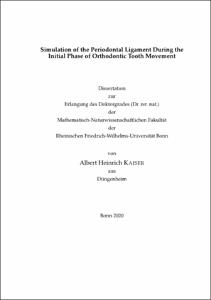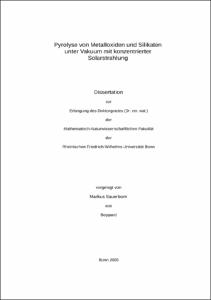Kaiser, Albert Heinrich: Simulation of the Periodontal Ligament During the Initial Phase of Orthodontic Tooth Movement. - Bonn, 2020. - Dissertation, Rheinische Friedrich-Wilhelms-Universität Bonn.
Online-Ausgabe in bonndoc: https://nbn-resolving.org/urn:nbn:de:hbz:5-59200
Online-Ausgabe in bonndoc: https://nbn-resolving.org/urn:nbn:de:hbz:5-59200
@phdthesis{handle:20.500.11811/8613,
urn: https://nbn-resolving.org/urn:nbn:de:hbz:5-59200,
author = {{Albert Heinrich Kaiser}},
title = {Simulation of the Periodontal Ligament During the Initial Phase of Orthodontic Tooth Movement},
school = {Rheinische Friedrich-Wilhelms-Universität Bonn},
year = 2020,
month = sep,
note = {The present work is concerned with the simulation of the periodontal ligament response to force in the initial phase of orthodontic tooth movement. This is based on two previous investigations at the Universitätsklinikum Bonn, namely the in vitro experiment of Papadopoulou et al. (2013) with specimens of porcine mandibular premolars, and the in vivo experiment of Konermann et al. (2017) on human upper first incisors.
For the curve fit of the in vitro experiment a model function, assuming viscoelasticity, was introduced. The viscoelastic model function was augmented by a ramp rise time term, to account for observed dependence of the response on actuator velocity, and a previous load history term, to account for the effect of the previous tests on the current test. The correlation coefficient of a curve fit for all tests grouped together was R²=0.98. Next, a curve fit of the in vivo experiment was done. Good correlation was found for a simplified model function, without viscoelastic term. Presumably due to the short test duration viscoelastic effects were not evident. For both tests, in vitro and in vivo, the ramp rise time term improved correlation.
The finite element model of Papadopoulou et al. (2013) was adapted for this investigation. The present work indicates that the macroscopic response of the periodontal ligament to an external load can be simulated with a poro-visco-hyperelastic model. For the hyperelastic model of the ground substance, Storåkers (1986) constitutive model was used, and parameters identified herein are in good agreement with values published in Bergomi et al. (2011). The simulation showed that poroelastic behaviour will gradually cease when viscoelastic relaxation progresses. This followed also from dimensionless analysis. As a consequence, for slow loading, or if initial response to fast loading is not of interest, a visco-hyperelastic model may suffice.
The curve fit of the model function conceived herein is in good agreement with measured data. The model function includes a ramp rise time term, which could not be covered with the poro-visco-hyperelastic simulation. A supposition to explain this effect on the micro scale is to assume strain rate hardening. For soft tissues strain rate effects were observed by other investigators, e.g. David Bell et al. (2018) and Burgin et al. (2014), however the underlying microstructural mechanism is still unknown. Papadopoulou et al. (2013) did not randomise the test sequence with respect to ramp rise time. Therefore, it can not be excluded that the effect is due to test sequence. To clarify this objection, further tests with randomised test sequence are recommended.},
url = {https://hdl.handle.net/20.500.11811/8613}
}
urn: https://nbn-resolving.org/urn:nbn:de:hbz:5-59200,
author = {{Albert Heinrich Kaiser}},
title = {Simulation of the Periodontal Ligament During the Initial Phase of Orthodontic Tooth Movement},
school = {Rheinische Friedrich-Wilhelms-Universität Bonn},
year = 2020,
month = sep,
note = {The present work is concerned with the simulation of the periodontal ligament response to force in the initial phase of orthodontic tooth movement. This is based on two previous investigations at the Universitätsklinikum Bonn, namely the in vitro experiment of Papadopoulou et al. (2013) with specimens of porcine mandibular premolars, and the in vivo experiment of Konermann et al. (2017) on human upper first incisors.
For the curve fit of the in vitro experiment a model function, assuming viscoelasticity, was introduced. The viscoelastic model function was augmented by a ramp rise time term, to account for observed dependence of the response on actuator velocity, and a previous load history term, to account for the effect of the previous tests on the current test. The correlation coefficient of a curve fit for all tests grouped together was R²=0.98. Next, a curve fit of the in vivo experiment was done. Good correlation was found for a simplified model function, without viscoelastic term. Presumably due to the short test duration viscoelastic effects were not evident. For both tests, in vitro and in vivo, the ramp rise time term improved correlation.
The finite element model of Papadopoulou et al. (2013) was adapted for this investigation. The present work indicates that the macroscopic response of the periodontal ligament to an external load can be simulated with a poro-visco-hyperelastic model. For the hyperelastic model of the ground substance, Storåkers (1986) constitutive model was used, and parameters identified herein are in good agreement with values published in Bergomi et al. (2011). The simulation showed that poroelastic behaviour will gradually cease when viscoelastic relaxation progresses. This followed also from dimensionless analysis. As a consequence, for slow loading, or if initial response to fast loading is not of interest, a visco-hyperelastic model may suffice.
The curve fit of the model function conceived herein is in good agreement with measured data. The model function includes a ramp rise time term, which could not be covered with the poro-visco-hyperelastic simulation. A supposition to explain this effect on the micro scale is to assume strain rate hardening. For soft tissues strain rate effects were observed by other investigators, e.g. David Bell et al. (2018) and Burgin et al. (2014), however the underlying microstructural mechanism is still unknown. Papadopoulou et al. (2013) did not randomise the test sequence with respect to ramp rise time. Therefore, it can not be excluded that the effect is due to test sequence. To clarify this objection, further tests with randomised test sequence are recommended.},
url = {https://hdl.handle.net/20.500.11811/8613}
}









